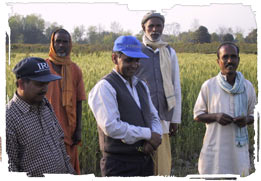|

Foliar blight has dried
the leaves and shriveled the grain of this wheat, making
it look like the crop is suffering from drought. |
El Batán, Mexico
November, 2005
Source:
CIMMYT E-News, vol 2 no.
11, November 2005
Knowing the
Enemy: Foliar Blight
CIMMYT and
partners in Nepal have identified new sources of genetic
resistance to a disease that makes wheat plants looks as though
they have been through a drought. The symptoms of foliar blight
result from fungal infections, either spot blotch or the less
well-known but related tan spot. These pathogens dry the wheat
plant and shrivel grain. In the warm areas of South Asia, that
appearance can lead farmers to blame drought rather than an
infection. By “knowing the enemy,” as CIMMYT partner
Ram Sharma
puts it, it is easier to win the fight against the disease.
CIMMYT pathologist
Etienne Duveiller and
Sharma, who have both done work on the pathogens, have found an
effective method to select for resistance: finding wheat with a
heavy grain weight, early maturity, and resistance to both
pathogens. Wheat that carries these three traits together makes
for wheat with higher resistance. Through regional collaborative
trials in South Asia, they have bred and identified wheat lines
that look promising. While better than anything previously seen
in the area, these wheats can still suffer up to 35% yield
losses—and have a huge impact on resource poor farmers who grow
their wheat for food, as most do in Nepal.
|

Sharma (center) and
colleague Baidya Nath Mahto (left) evaluate foliar
blight with farmers in Nepal. |
When the
temperature soars to 26-28°C, however, no wheat can resist the
disease. This is why it is so important to find wheat that
matures early to avoid the abrupt rise in temperature
accompanied by hot winds in late March and April. This becomes
difficult as most farmers in the region are delayed planting
wheat as they wait for their rice harvest to finish and the
paddies to dry up.
In addition to
genetic resistance, solutions can come in the form of good
management. Surface seeding, when seed is broadcast on the mud
directly after the rice harvest, allows earlier planting and
gives the wheat crop a jump start on the heat. Crop rotation and
soil nutrients are important because healthy soils help the crop
resist the disease. Also, Duveiller and Sharma have found that
wheat is better able to withstand the disease with proper soil
moisture.
The CIMMYT-Nepal
team expects that these new sources of resistance, coupled with
good management practices, will limit the destructiveness of
this disease. They know it can be done—foliar blight has already
been substantially reduced in areas of South Asia such as
Bangladesh through better wheat varieties. The challenge is to
sustain progressive control of this threat across the warm wheat
growing areas of South Asia. |